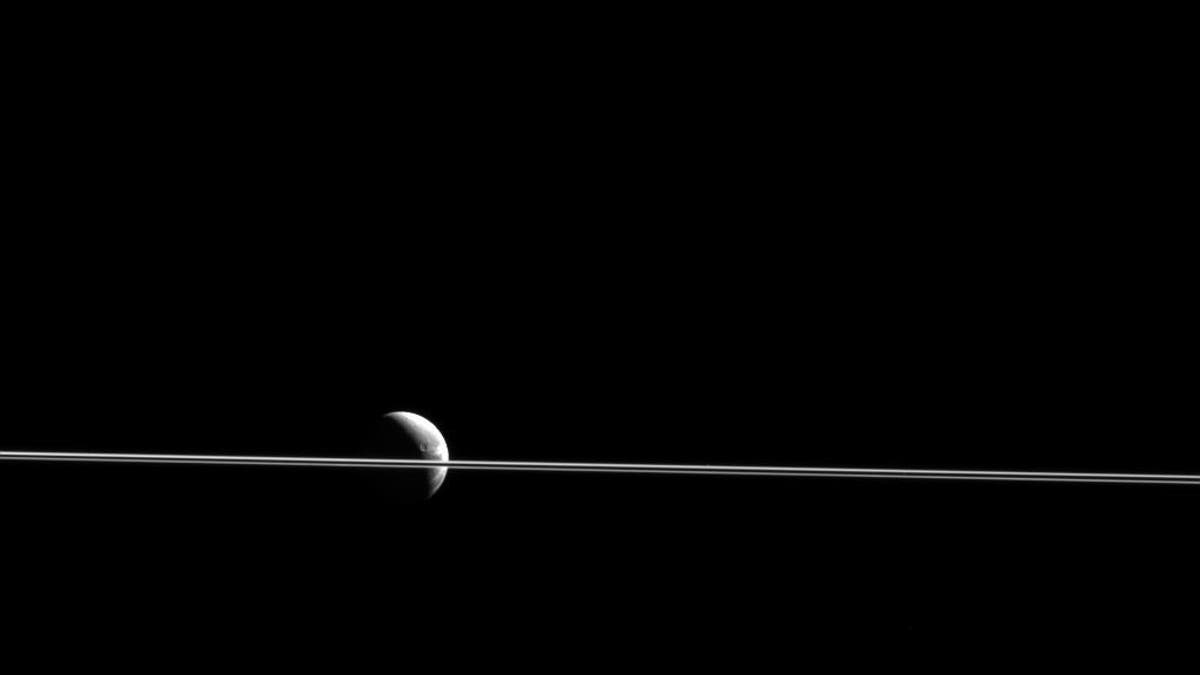
Dione appears cut in two by Saturn's razor-thin rings, seen nearly edge-on in a view from NASA's Cassini spacecraft. This scene was captured from just 0.02 degrees above the ring plane. (NASA/JPL-Caltech/Space Science Institute)
Saturn’s icy moons, as well as its famous rings may only be hundred million years old, suggesting they formed during the reign of many dinosaurs.
First discovered in the 1600s, astronomers have long debated the age of the moons and Saturn’s rings. To come up with an age, researchers used computer modeling to infer the moon’s past dynamic behavior. Then, they compared present orbital tilts and those predicted by computer simulations to learn how much the orbits of Saturn’s moons have grown.
Related: NASA finds highest peak on Saturn's largest moon Titan
It turns out that for some of the most important satellites – Tethys, Dione and Rhea – the orbits are less dramatically altered than previously thought. That would suggest that they haven’t crossed many orbital resonances, meaning that they must have formed not far from where they are now and thus are younger than thought.
“Moons are always changing their orbits. That’s inevitable,” Matija Cuk, principal investigator at the SETI Institute who together with Luke Dones and David Nesvorny of the Southwest Research Institute published their findings in the journal Astrophysical Journal, said in a statement.
“But that fact allows us to use computer simulations to tease out the history of Saturn’s inner moons,” Cuk said. “Doing so, we find that they were most likely born during the most recent 2 percent of the planet’s history."
Related: Saturn's largest moon Titan is bursting with color
Researchers had long thought Saturn’s rings were as old as the planet itself. But that thinking changed in 2012, when French astronomers found that tidal effects – the gravitational interaction of the inner moons with fluids deep in Saturn’s interior – are causing them to spiral to larger orbital radii comparatively quickly. The implication, given their present positions, is that these moons, and presumably the rings, are not so old.
That still didn’t answer exactly when they were born.
Cuk and his team turned to results from NASA’s Cassini mission, which has observed ice geysers on Saturn’s moon Enceladus.
Assuming that the energy powering these geysers comes directly from tidal interactions and that Enceladus’ level of geothermal activity is more or less constant, then the tides within Saturn are quite strong. According to the team’s analysis, these would move the satellite by the small amount indicated by the simulations in only about 100 million years.
Related: Cassini probe takes 'cosmic bulls-eye' of Saturn moons Enceladus,Tethys
This would date the formation of the major moons of Saturn, with the exception of more distant Titan and Iapetus, to the relatively recent Cretaceous Period, the era of the dinosaurs.
“So the question arises, what caused the recent birth of the inner moons?” Cuk wondered. “Our best guess is that Saturn had a similar collection of moons before, but their orbits were disturbed by a special kind of orbital resonance involving Saturn’s motion around the Sun. Eventually, the orbits of neighboring moons crossed, and these objects collided. From this rubble, the present set of moons and rings formed.”




















